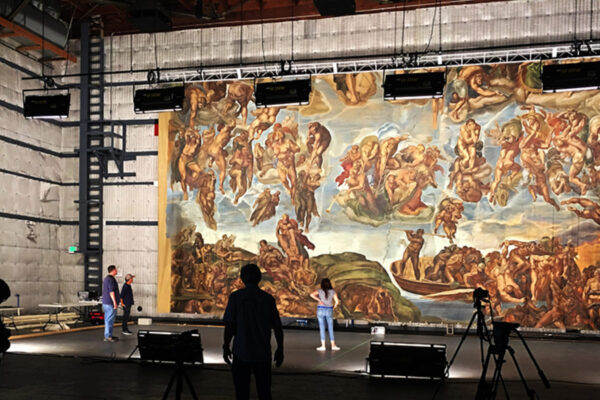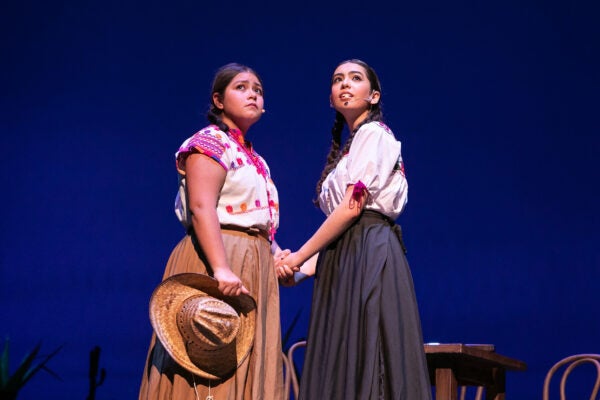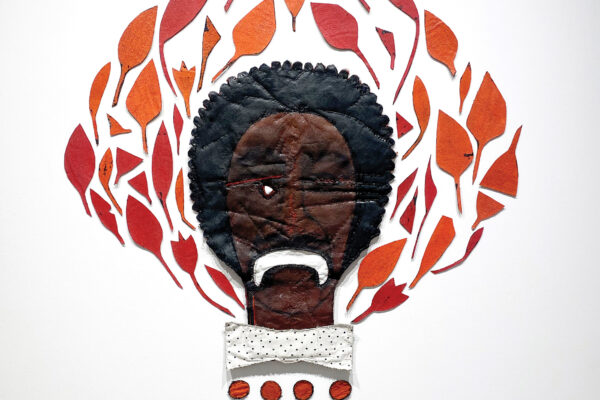Humphrey Bogart and Ingrid Bergman fall in love while driving along the Champs-Élysées in the film “Casablanca.” Judy Garland skips through a land she finds over the rainbow in “The Wizard of Oz.” Clark Gable walks away from Vivien Leigh into a distant Southern horizon in “Gone With the Wind.”
Except none of these actors and actresses was where he or she seemed to be. They were moving, loving and vanishing in front of backdrops painted during the golden age of Hollywood film in the early to mid-1900s. The artists who created these works emulated the highest standards of classical painting and realized specific techniques that were designed to trick the eye.
Since that time, Hollywood backdrops have evolved. They still find their way into films by directors such as the Coen brothers, Robert Rodriguez, Quentin Tarantino, Jon Favreau and Steven Spielberg, just to name a few. But modern backdrops, more often than not, are digitally designed and printed. Today, scenic artists who understand hand-drawn and painted perspectives that transform two-dimensional spaces into three-dimensional worlds can be more difficult to find.
Karen Maness, a lead instructor of scenic art at The University of Texas at Austin and the scenic art supervisor for Texas Performing Arts, is a national authority on the subject of Hollywood backdrop painting. In 2012, the Art Directors Guild for the motion picture industry chose Maness to interview and document some of its members whom she calls the “lucky last” — painters with knowledge of this art form who were working at the top of their industry in the final years of Hollywood motion picture backdrop painting. She conducted her interviews at J.C. Backings, a family-owned backdrop rental company, in the historic MGM Studios. It was here she first came into contact with hundreds of backdrops, many of which made their way into the book she co-authored, “The Art of the Hollywood Backdrop.”
Two years after the book was published, Maness received a call. J.C. Backings was leaving the MGM scenic studio and releasing many famous and obscure film backdrops from their inventory. A race was on to preserve these pieces of film history.
Texas Connect spoke with Maness about her 30 years of work as a scenic artist, her passion for recovering and preserving these historical backdrops and how she strives to instill students at The University of Texas at Austin with fluency in both digital and analog scenic art production. Some answers have been edited for clarity and length.
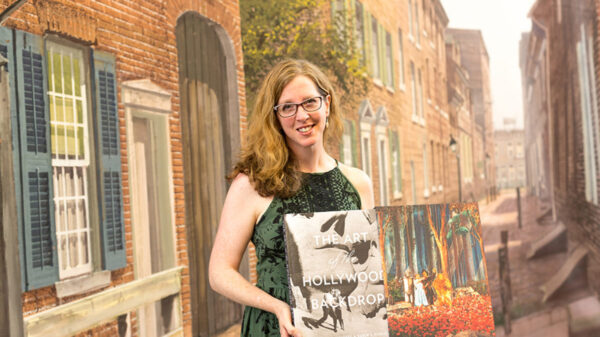
What brought you to Austin after working in the industry in Los Angeles?
I moved here to run the scenic art studio at Texas Performing Arts. It’s funny; I had never worked a full yearlong contract before here. I had always signed 10-month contracts and then freelanced to make money. I went from saying, ‘Don’t lock me down, dude! It’s freaking me out!’ to being here for 20 years.
And I fell in love with teaching. In addition to teaching scenic art and figurative painting, I teach project-based classes as part of a program born here at Texas Performing Arts called Texas Applied Arts with my colleague J.E. Johnson. And now I just love this place. There’s so much potential here. What we have here is so precious.
What is the Backdrop Recovery Project?
I co-wrote a book on the history of backdrop painting for the Hollywood motion picture industry that came out in 2016.
From that research, I came to know the holdings of J.C. Backings, a backdrop company in Los Angeles, and the family’s connection and contribution to some of the most important scenic painting in Hollywood’s motion picture history. They were leaving the historic MGM space, and they were not going to hold on to all their backdrops. The company contacted the Art Directors Guild, and then I was contacted.
It suddenly became a mad rush to see what to do with the 207 pieces they were not keeping in their rental inventory.
How did you acquire 50 of these classic Hollywood backdrops?
Texas Performing Arts and the College of Fine Arts decided to support acquiring these as teaching assets.
I flew out to Los Angeles to be part of the opening and discovery process at a soundstage on the Sony Studios lot for the ADG Archives Backdrop Recovery Project. Some of the MGM backings had not been opened in over 30 years. There were backdrops from “Forbidden Planet,” from “Singing in the Rain.” It was extraordinary. The most famous ones we have here at UT are a full-sized copy of the Sistine Chapel backdrop from “Shoes of the Fisherman,” two from “National Velvet,” a beautiful cathedral interior from “The Student Prince” and many others from more obscure films. Each was selected as an excellent example of cinematic painting that’s specific to the camera.
If you had not recovered these backdrops, what would J.C. Backings have done with them?
They could have ended up like much of Hollywood history — abandoned in the dead of night and in a landfill. There have been thousands of these kinds of backdrops lost to history. The reason why they remained at all is because they were hidden in plain sight, rolled up and stacked onto high racks. When MGM divested its assets, much that could not be sold was dumped into dumpsters, but these backings were missed. When J.C. Backings moved into the MGM space, they purchased all of those MGM backdrops.
Those assets became part of their inventory, along with the backdrops they had purchased from 20th Century Fox and the hundreds they had painted over the years. They have an unbelievable collection — a treasure trove.
Their company is still very much intact, but they do photographic and digital backdrops now, not nearly as much painting, so they didn’t need all the space they had at MGM.
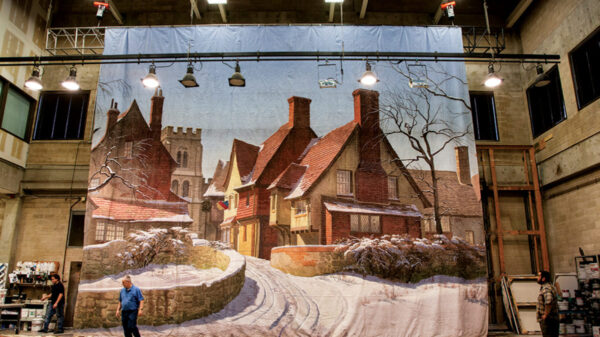
How did you choose which backdrops you specifically wanted at UT?
I tried as much as possible to bring paintings to UT Austin that were in the book since this is where the book was nurtured into existence. The finest and most historically relevant paintings went into the collection of the Academy of Motion Pictures Arts and Sciences. Some of the others went to the Gene Autry museum, Cobalt Studios in New York and Chapman University in Orange County.
What do these backdrops mean to you?
I love painting. I just love it. And now… I’m endeavoring to continue to teach this skill to the next generation. We have lost so much language of painting with the advent of printing. I mean, J.C. Backings, the company that gave us these paintings, is evidence of the evolution of the motion picture backdrop business. Most of their business is now digital and photographic printing. They’re using their family’s knowledge of painting to create highly effective translucent printed backdrops; they have a dynastic family of scenic artists and knowledge that goes back a hundred years in Hollywood. They used that knowledge to successfully pivot into this new age of media needs. As the work of motion picture scenic painting diminished, the opportunity to transfer this knowledge and practical experience of painting cloths hundreds of feet long was not passed onto the next generation.
I’m interested in teaching digital-analog fluidity. It is necessary for success in the 21st century. Those who know the analog side of painting will have a significant advantage if they know how to see, how to mix colors, and how to do the work physically.
What do they teach students?
Mike Denering (an industry colleague) told me, when we were acquiring these backdrops, ‘Everything you need to know about painting is in those backdrops. Deconstruct them, and then you could pass that knowledge on to another generation.’
It’s thrilling. So that is why I am opening up these paintings, to learn from lost masters and translate their deep knowledge to my students.
We’ve only just started teaching from the backdrops. The students are going from very foundational perspective drawings to now copying works of master artists of the high renaissance of backdrop painting — for the third painting ever done in their life.
The bar was beyond high. I’m happy to share what they did. They were stunning. And they all surprised themselves.

